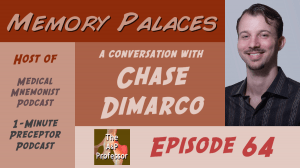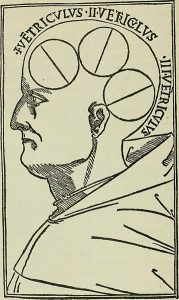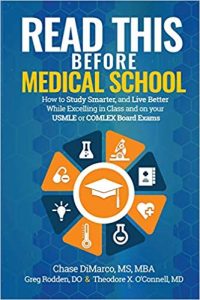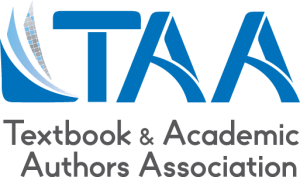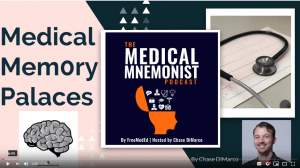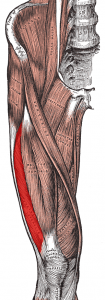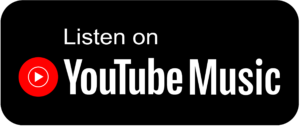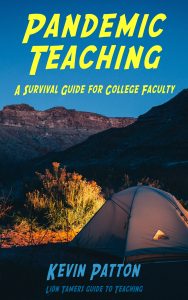Memory Palaces with Chase DiMarco
TAPP Radio Episode 64
Preview Episode
Preview | Quick Take
A brief preview of the upcoming full episode, featuring upcoming topics—a chat with Chase DiMarco—plus word dissections, a book club recommendation, and more!
00:19 | Topics
01:19 | Sponsored by HAPI Online Graduate Program
01:46 | Word Dissection
06:45 | Sponsored by HAPS
07:06 | Book Club
10:13 | Survey Says…
10:42 | Sponsored by AAA
11:02 | Staying Connected
Preview | Listen Now
Preview | Show Notes
Upcoming Topics
1 minute
In the full episode, I’ll chat with mnemonist, author, and podcaster Chase DiMarco about a powerful memory technique called a “memory palace.”
Sponsored by HAPI Online Graduate Program
0.5 minute
The Master of Science in Human Anatomy & Physiology Instruction—the MS-HAPI—is a graduate program for A&P teachers. A combination of science courses (enough to qualify you to teach at the college level) and courses in contemporary instructional practice, this program helps you power up your teaching. Kevin Patton is a faculty member in this program. Check it out!
Word Dissection
5 minutes
- mnemonic (again!)
- mnemonist
- loci (and locus) not Loki
Sponsored by HAPS
0.5 minute
The Human Anatomy & Physiology Society (HAPS) is a sponsor of this podcast. You can help appreciate their support by clicking the link below and checking out the many resources and benefits found there. Don’t forget the early-bird discount for the HAPS Annual Conference expires on February 21, 2020—the same deadline for submitting workshops and posters.
Book Club
3 minutes
- Read This Before Medical School: How to Study Smarter and Live Better While Excelling in Class and on your USMLE or COMLEX Board Exams
- by Chase DiMarco, Theodore X. O’Connell, Greg Rodden
- amzn.to/2ThbBwv
- For the complete list (and more) go to theAPprofessor.org/BookClub
- Special opportunity
- Contribute YOUR book recommendation for A&P teachers!
- Be sure include your reasons for recommending it
- Any contribution used will receive a $25 gift certificate
- The best contribution is one that you have recorded in your own voice (or in a voicemail at 1-833-LION-DEN)
- Contribute YOUR book recommendation for A&P teachers!
- For the complete list (and more) go to theAPprofessor.org/BookClub
Survey Says…
0.5 minute
- Please take about 5 minutes to answer some questions—it will really help improve this podcast!
Sponsored by AAA
0.5 minutes
- A searchable transcript for this episode, as well as the captioned audiogram of this episode, are sponsored by the American Association for Anatomy (AAA) at anatomy.org.
- Don’t forget—HAPS members get a deep discount on AAA membership!
Preview | Captioned Audiogram
Post Preview Episode
Post Preview | Listen Now
Post Preview | Show Notes
Mistake!
2 minutes
Yikes, because of a scheduling error, Preview Episode 64 was released a week early. So here’s special post preview episode to bridge the gap, so you won’t think you missed an episode!
HAPS Conference Guide
1 minute
I need your questions, tips, strategies, stories NOW for the upcoming 2020 edition of Kevin’s Unofficial Guide to the Annual HAPS Conference. Like right now!
Survey Says…
0.5 minute
- Please take about 5 minutes to answer some questions—it will really help improve this podcast!
Word Dissection
6 minutes
COVID-19—what does it mean and where did it come from? And who cares, anyway?
Clarification:
- COVID-19 is the shortened name of the illness.
- Coronavirus Disease 2019 is the full name of the illness.
- SARS-CoV-2 is the name of the virus that causes it.
- my-ap.us/38Du6Rl
Stay up to date with reliable information about COVID-19 and other topics of interest to A&P teacher by subscribing to my daily headlines at Updates
[revue_subscribe]
Update! The update newsletter has been migrated from Nuzzel to Revue!
Textbook & Academic Authors Association (TAA)
4 minutes
TAA is a professional development organization that helps authors of instructional materials (including textbooks) and of academic journals and books to become more effective writers. Help with legal issues (e.g., contracts, permissions, copyright), time management, writing skills, coaching, and many other needs are found within a variety of powerful resources such as articles, books, webinars, seminars, and conferences.
Sponsors
0.5 minute
Human Anatomy & Physiology Instruction (HAPI)
Online graduate program for holders of advanced degrees who want a comprehensive review of core principles of both anatomy and physiology, introduction to contemporary teaching practice, hands-on practice in course design and implementation, navigating the roles of college faculty, and collaboration with peers in building a solid portfolio in teaching human anatomy and physiology.
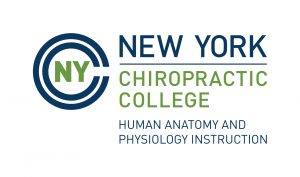
- A searchable transcript for this episode, as well as the captioned audiogram of this episode, are sponsored by the American Association for Anatomy (AAA) at anatomy.org.
- Don’t forget—HAPS members get a deep discount on AAA membership!
The Human Anatomy & Physiology Society (HAPS)
You can help appreciate their support by clicking the link below and checking out the many resources and benefits found there.
Preview | Captioned Audiogram
Regular Episode
Episode | Quick Take
Host Kevin Patton chats with mnemonist (memory expert) Chase DiMarco, who helps medical students learn. DiMarco describes how to use memory palaces in learning human anatomy and physiology.
00:44 | Introducing Chase DiMarco
02:33 | Sponsored by AAA (Silverthorn toast)
03:53 | What Is a Memory Palace?
11:44 | Sponsored by HAPI
12:07 | Building a Memory Palace
22:53 | Sponsored by HAPS
23:16 | Helping our Students
27:51 | Staying Connected
Episode | Listen Now
Episode | Show Notes
Memory is the treasury and guardian of all things. (Marcus Tullius Cicero)
Introducing Chase DiMarco
2 minutes
Chase DiMarco is memory expert (mnemonist), medical education entrepreneur, MBA, and MD-PhD candidate. He specializes in helping medical and health sciences students succeed in learning and remembering large amounts of information in a short time. Which is what these students need, right?
- Founder of FreeMedEd
- Host of Medical Mnemonist Podcast
- Host of 1-Minute Preceptor Podcast
- Social media:
- Faculty can book a one-on-one chat with Chase DiMarco at
- Students or faculty can get personalized tutoring at
- Read This Before Medical School: How to Study Smarter and Live Better While Excelling in Class and on your USMLE or COMLEX Board Exams
- Chase DiMarco’s book
- amzn.to/2ThbBwv
- Reviewed by Kevin Patton at
- Book Club for Anatomy & Physiology Professors
- Episode 64 Preview (book club segment) theAPprofessor.org/64#pre
Sponsored by AAA
1.5 minutes
A searchable transcript for this episode, as well as the captioned audiogram of this episode, are sponsored by the American Association for Anatomy (AAA) at anatomy.org.
Don’t forget—HAPS members get a deep discount on AAA membership!
A toast:
- Congratulations 🥂 to Dee Silverthorn’s induction as a Fellow of the American Association of Anatomy (FAAA)!
- And to ALL the new members of the Fellows Circle!
- my-ap.us/2T2BOjo
What Is a Memory Palace?
8 minutes
A “memory palace” is a mnemonic device or technique in which a learner imagines a location such as a house or room and places concepts or terms to be remembered at specific locations within it. This helps a person remember a large group of things by remembering their location in the imagined location.
This technique is also called “method of loci”—and bunch of other synonyms that one would need a memory palace to remember.
- Memory Palaces for Medicine (video tutorial on how to use the technique)
- Podcast episodes of interest:
- Blog post:
Sponsored by HAPI Online Graduate Program
0.5 minute
The Master of Science in Human Anatomy & Physiology Instruction—the MS-HAPI—is a graduate program for A&P teachers. A combination of science courses (enough to qualify you to teach at the college level) and courses in contemporary instructional practice, this program helps you power up your teaching. Kevin Patton is a faculty member in this program. Check it out!
Building a Memory Palace
11 minutes
Memory palaces are one of the tools in the toolbox that we can offer our A&P students. This one takes Practice. Practice. Practice. —but can really pay off in increased retention and retrieval!
Sponsored by HAPS
0.5 minutes
The Human Anatomy & Physiology Society (HAPS) is a sponsor of this podcast. You can help appreciate their support by clicking the link below and checking out the many resources and benefits found there. Don’t forget the HAPS Awards, which provide assistance for participating in the HAPS Annual Conference.
It’s coming soon! 🤗
Kevin’s Unofficial Guide to the HAPS Annual Conference | 2019 Edition | Episode 42
LAST CALL! Now is a good time to submit your questions, comments, tips, & stories for the upcoming 2020 edition!
Survey Says…
0.5 minute
Please take about 5 minutes to answer some questions—it will really help improve this podcast!
Yes; I’ll give you extra credit if you fill out a survey!
Need help accessing resources locked behind a paywall?
Check out this advice from Episode 32 to get what you need!
Episode | Captioned Audiogram
Preview | Transcript
The A&P Professor podcast (TAPP radio) episodes are made for listening, not reading. This transcript is provided for your convenience, but hey, it’s just not possible to capture the emphasis and dramatic delivery of the audio version. Or the cool theme music. Or laughs and snorts. And because it’s generated by a combo of machine and human transcription, it may not be exactly right. So I strongly recommend listening by clicking the audio player provided.
 This searchable transcript is supported by the
This searchable transcript is supported by the
American Association for Anatomy.
I'm a member—maybe you should be one, too!
Introduction
Kevin Patton:
Hi there. This is Kevin Patton with a brief audio introduction to episode number 64 of the A&P Professor podcast, also known as TAPP Radio, an audio salon for teachers of human anatomy and physiology.
Topics
Kevin Patton:
In the upcoming full episode, that is episode 64, I’m going to have a conversation with Chase DiMarco. Now, Chase DiMarco is widely known as a mnemonist, that is a memory expert. He’s also a consultant and entrepreneur and, believe it or not, in addition to that, he’s an MD/PhD candidate who has a passion for helping medical students succeed in their studies and in their professional exams.
Kevin Patton:
Now, I got a lot of support from my recent discussions of flashcard techniques in episodes 58, 59 and 60, and this conversation will compliment those with an explanation of a study technique sometimes called a memory palace, which is based on something very old and very effective called the method of loci. But wait for the full episode 64, where you’ll get to know Chase and learn a lot more about this memory technique.
Sponsored by HAPI Online Graduate Program
Kevin Patton:
The free distribution of this podcast is sponsored by the Master of Science and Human Anatomy and Physiology instruction, the HAPI degree. I’m on the faculty of this program, so I know the incredible value it is for A&P teachers. Check out this online graduate program at nycc.edu/hapi or click the link in the show notes or episode page,
Word Dissection
Kevin Patton:
You guessed it. It’s time, once again, for word dissection where we practice what we all do in our teaching and take apart words and translate their parts to deepen our understanding. Sometimes they’re old and familiar terms and sometimes they’re terms that are new to us, or maybe they’re so new that nobody knows them yet because they just got made up by somebody.
Kevin Patton:
Today we have a few related to our main topic and that is this memory technique that we’re going to be discussing with Chase DiMarco, and the first term has come up before, actually more than once and past episodes, and we did dissect it once back in episode number 59 and that is the word mnemonics.
Kevin Patton:
So, just to refresh our memories a little bit, that word part mnemon means memory. Literally, it means mindful, but we use it in terms of memory, and then the IC ending means relating to, so mnemonic, when you put it all together means relating to memory and it usually refers to something that aids memory.
Kevin Patton:
It can be a mnemonic sentence or phrase where the first letter of each word, and the mnemonic sentence has the same first letter of items in the list that we want to remember, but there are other mnemonic techniques and we’re going to be discussing one of those techniques in the full episode.
Kevin Patton:
Now regarding pronunciation, I find myself going back and forth between nemonic and mnemonic and that usually depends on the context of words around it and my brain just goes there whether I want it to or not, and it just comes right out of my mouth and maybe there are things like that that you do too.
Kevin Patton:
Now, the latter pronunciation, mnemonic, is preferred by most of the sources I looked at, so I’m going to try and stick with that as much as I can here. We’ll see how that goes.
Kevin Patton:
The next word on the list is a related term. It’s actually just another version of the word mnemonic and that is mnemonist and it’s the same as mnemonic, but we’re going to swap out that IC ending in mnemonic and put in IST ending, which means an agent or a performer of something, and so a mnemonist literally then is a person, an agent, a performer, someone who performs memory.
Kevin Patton:
Most often, that term in the English language is used to describe someone who is adept at or skilled in feats of memory like, I don’t know, remembering the order of cards in a shuffled deck, or memorizing as much as they can from a page from a phone book, or maybe trying to learn all the bones of the skeleton.
Kevin Patton:
Yeah, that’s a feat of memory and that takes some work, and maybe there’s some techniques that we can use to make that go more simply for students. It’s still going to be hard, but maybe there’s a way to help them organize that and get it done quickly and effectively, and really be able to retrieve that information when it needs to be retrieved.
Kevin Patton:
And yeah, I sometimes find myself pronouncing it nemonist sometimes. Actually, that does show up occasionally and dictionaries, but it’s most often pronounced mnemonist or mnemonist. I sometimes mistakenly use nematist instead of mnemonist. I don’t know where that comes from. But anyway, I swap out the end for a T, go figure. I promise to work on that if you promise to overlook my mistake. Okay?
Kevin Patton:
The next term on our word dissection list is loci, L-O-C-I. It’s a word that’s going to come up related to a mnemonic technique that we’re going to be discussing in the full episode. It can be pronounced loci, as I just did, but other common pronunciations are losi, or low key. But, when I hear it pronounce it that way, low key, I think of that trickster from Norse mythology, Loki. L-O-K-I. So, loci it is for me. But you get to pick your favorite.
Kevin Patton:
Loci is the plural form of the Latin word locus, L-O-C-U-S, which we also use as is an English, meaning place or location. In fact, the word location is derived from the word locus. We sometimes use a locus in genetics to describe the physical location of a gene within a chromosome, so you may have run across that use already.
Kevin Patton:
Loci is the plural form of locus, so it’s simply means places. We’re going to be talking about a technique sometimes called the method of loci, which we can now more easily see, simply means method of places.
Sponsored by HAPS
Kevin Patton:
This podcast is sponsored by HAPS, the Human Anatomy and Physiology Society, promoting excellence in the teaching of human anatomy and physiology For over 30 years. Go visit HAPS at theAPprofessor.org/haps. That’s H-A-P-S.
Book Club
Kevin Patton:
Hey, let’s step into the bookshop and see what we may want to add to our personal and professional bookshelf. I’m going to go straight over to the medical shelf this time because I know exactly which book I’m looking for. It’s called, Read This Before Medical School: How to study smarter and live better while excelling in class and on your USMLE or COMLEX board exams. It’s by Chase DiMarco, Theodore X. O’Connell, and Greg Rodden. Recognize that name? Chase DiMarco. He’s the guy I’m chatting with in the upcoming full episode 64.
Kevin Patton:
And you can tell from the title, this book is for students in medical school and you may teach medical students or students in some other health profession program, or maybe you’re teaching A&P to pre-meds or pre-nursing, or any of the many other students in the typical A&P course. This book could be helpful to any of them, really.
Kevin Patton:
Why? Because all the students had just mentioned are being hit with what surely feels like a fire hose of information. It feels that way because it really is a lot of information and ideas to learn in a very short period of time and most of them will eventually be facing licensing or other professional exams of some sort, right? Whether it’s COMLEX or NCLEX, or even tryouts for Jeopardy.
Kevin Patton:
The advice and strategies offered in the book could be a game changer for some students. This book covers all the important things to consider when trying to figure out how to succeed in A&P. For example, why study skills are important, why class participation is essential, how use the teachers’ time and resources effectively, using the school’s resources, how to study at home, making a study plan and managing time effectively? A lot of my students could use it. I could use that.
Kevin Patton:
The value of study groups and how to organize and run a study group, and even how to optimize work-life balance. There’s also a big section on test prep with strategies for both course exams and those big professional exams I just mentioned a moment ago.
Kevin Patton:
And because there’s a lot of memorization required in A&P, yeah, you know there is, right? There’s a big section on memory strategies. This is a great book to have on your teaching shelf to offer to students as a place to start learning how to study and how to handle that fire hose of ideas in A&P or perhaps add to your list of recommended resources for your students.
Kevin Patton:
Just go to the show notes or episode page or theAPprofessor.org/bookclub to take a look at this book, and be sure to listen to the full episode 64 featuring a chat with the author, Chase DiMarco.
Survey Says…
Kevin Patton:
Hey, you probably forgot about that survey that I’ve been taking that’s part of my end of season debriefing. I’m asking you now to please take just a few minutes of your time to respond to that anonymous survey because it’s your experience as an individual listener that’s important to me. Just go to theAPprofessor.org/survey, and as always, thanks for your support.
Sponsored by AAA
Kevin Patton:
A searchable transcript and a captioned audiogram of this preview episode are funded by AAA, the American Association for Anatomy. Check out their many resources and events on their newly redesigned website at anatomy.org.
Staying Connected
Kevin Patton:
Well, this is Kevin Patton signing off for now and reminding you to keep your questions and comments coming. Why not call the podcast hotline right now at 1-833-LION-DEN. That’s 1-833-546-6336, or visit us at the theAPprofessor.org. I’ll see you down the road.
Preview | Transcript
The A&P Professor podcast (TAPP radio) episodes are made for listening, not reading. This transcript is provided for your convenience, but hey, it’s just not possible to capture the emphasis and dramatic delivery of the audio version. Or the cool theme music. Or laughs and snorts. And because it’s generated by a combo of machine and human transcription, it may not be exactly right. So I strongly recommend listening by clicking the audio player provided.
 This searchable transcript is supported by the
This searchable transcript is supported by the
American Association for Anatomy.
I'm a member—maybe you should be one, too!
Kevin Patton:
Hi there. This is Kevin Patton with yet another brief audio introduction to episode number 64 of The A&P Professor podcast, also known as TAPP Radio, an audio smorgasbord for teachers of human anatomy and physiology.
Kevin Patton:
I know this is weird, but if you noticed in the introduction I said that this is yet another brief audio introduction to episode number 64. What that means is it’s really kind of the second preview episode. Normally there’s a preview episode, then a full episode and a preview episode and a full episode, but this time there’s two preview episodes kind of sort of. This one’s going to be really brief and it’s not going to have the usual elements of a preview episode. But I wanted to put this out here because, well, last Thursday I released the preview accidentally. It was a mistake. You remember back in episode 63 I said that everybody makes mistakes and that’s okay. And even if they’re very public and we can’t take them back, it’s okay. So hopefully you’re okay with my big mistake because when I released that bonus episode in between about how to prepare for COVID-19 and influenza disruptions and of course I messed up the scheduling.
Kevin Patton:
I meant to push episode 64 back a week. And so I pushed the full episode back a week, but the preview episode dropped too early. So it dropped last Thursday and now some of you are expecting on Monday for the full episode to come out and it’s not. It’s not going to come out until next Monday. And so I didn’t want to leave you all hanging there and think that you did something wrong because it was me that did something wrong. So this is all a big mistake, but that’s okay. There’s a couple of interesting things that I wanted to share with you anyway and so that gives me the opportunity to do it. And then mainly I just want to tell you to hang on. The new episode’s coming. It’s coming next week and it’s going to be a great one with Chase DiMarco who’s going to tell us about memory palaces, what they are and how they can help students remember a lot of information that’s all related to one another, so that’s in the upcoming full episode, episode number 64.
Kevin Patton:
Having this extra little episode in between the other scheduled episodes gives me the opportunity to remind you once again that I’m getting ready to prepare Kevin’s Unofficial Guide to the HAPS Annual Conference, the 2020 Edition and I’ve been putting it out there for a little while that I would love your tips, your positive stories about your HAPS conference experiences, your questions about how to prepare for or what’s to expect at a HAPS annual conference. So I need those right away, like right away so that I can get them into this year’s edition of Kevin’s Unofficial Guide to the HAPS Annual Conference. So please send those in as soon as you can.
Kevin Patton:
Here it is again. You remember that survey that’s going to help me with making this podcast more like what you really, really want to hear in a podcast. Oops. Yeah, I know. I do it too. You meant to fill it out for me, but you just keep forgetting. So here’s another gentle reminder about the short, easy survey put together by a team of podcast analysts at Podtrac to see who’s listening and help figure out what’s working and what’s not. Hey, it’s your experience as an individual listener that’s important to me. Just go to theAPprofessor.org/survey. And you know what? If you want to just call me up and chat about it, feel free to do that too, really.
Kevin Patton:
We’ve already suspended any dependence on a linear timeframe. And I didn’t have time to do a preview episode for bonus episode 63b. That’s the one where I outline strategies for preparing our courses and ourselves for potential disruptions to our course caused by disease outbreaks. But I have time now in this unexpected preview. Actually post preview episode, to circle back and do an important word dissection. And that term that we’re going to dissect is COVID-19 and of course that’s the official name designated by the World Health Organization for the disease in which we’re experiencing outbreak right now. Now there are other outbreaks going on. I know they’re influenza outbreaks and measles outbreaks in various areas of the world. But I’m going to focus now on the one that’s taking up all the news space and that is COVID-19. And that is an important term and we’ll see why in just a moment.
Kevin Patton:
First, let’s break it down. That is dissect it. The first word part is CO, C. O. And that stands for corona, like in coronavirus. And the VI also is part of that term coronavirus. VI stands for virus and then the D stands for disease. So COVID is a designation in this case, at least not of the virus, but of the disease caused by that virus. So COVID is short for coronavirus disease and then we have a hyphen 19 and we don’t want to forget that because there might be other kinds that come along. So we want to be very specific and of course 19 is short for 2019 which is the year the outbreak was first identified. The World Health Organization came up with this name for several reasons. One is we want to have one name that everybody uses and not everybody is using it yet.
Kevin Patton:
And I don’t know, I think as an A&P teacher, I’m one of those folks that people look to for some of their science information. My students look to me, my colleagues in other disciplines look to me, my friends and family often look to me for being accurate in terms of science that is important in society. Because that role has been thrust upon me whether I want it or not, I’m going to be careful about the way I talk about things like COVID-19 and I’m going to try my best to call it COVID-19 and not the coronavirus outbreak or just coronavirus because that term is not very specific. Coronavirus can mean a lot of different things. That is, it’s a broad umbrella of viruses and I’m not talking about the virus itself necessarily. I’m talking about the disease caused by that virus. So COVID-19 is the most appropriate, most accurate and therefore the safest term for us to use.
Kevin Patton:
And so I’m going to do my best to be one of those folks trying to get everybody to use that term when that’s what they’re talking about. And we all know that there have been previous names that were used leading up to this, so some people called it the Wuhan virus. Some people called it the China coronavirus and eventually we start calling it the novel coronavirus pneumonia. And then it was 2019 NCOVI acute respiratory disease, which is a mouthful. And that’s one of the goals of the World Health Organization in coming up with COVID-19, they wanted something easy to pronounce, short, easy to spell that everybody could wrap their tongues around and kind of understand each other in terms of what we meant. Another thing they wanted to do was avoid regional designations and that’s why, and I didn’t realize this, but they really tried to avoid using terms like Spanish flu, which came up in that bonus episode.
Kevin Patton:
Maybe I shouldn’t have been using that term Spanish flu. Maybe I shouldn’t be saying it now. And then SARS, remember was originally Middle East Respiratory Syndrome, MERS. And so we want to avoid that these days too because we don’t want to have discussion about diseases having a negative impact on places or even on brands of beer, which I personally happen to like Corona beer. But there’s some people who think that that’s somehow related to coronavirus. You and I know that’s silly, but that’s how things happen. It’s miscommunications. So let’s communicate accurately with COVID-19. One of the things I’m going to try and do is really keep up with the latest because I think I have this role whether I want it or not. And so I’m going to do my best to look at reliable evidence-based resources because this is becoming very politicized and distorted and so on in conversations that I hear around me.
Kevin Patton:
And so I want to make sure I have accurate information and remember that I do have that Nuzzel newsletter while I try and curate what I think are reliable resources. Now, of course I like anyone can make mistakes, but I’m trying to keep up with some of the new information about the COVID-19, see, I almost did that, COVID-19 outbreak and so that could be one of your sources to look at. Maybe every day check my Nuzzel newsletter. There’s a link in the show notes and episode page, but you can also just go to nuzzel and that’s N. U. Z. Z. E. L. .com/theAPprofessor and subscribe to my daily list of headlines and that will link directly to these resources. Now there’re all kinds of other updates as well, but I am trying to keep up with the COVID-19 updates.
Kevin Patton:
Well this is a really weird episode. I mean like way weirder than normal. So maybe now’s a good time to bring up a resource that’s been on my mind and I think you’ll find useful, but it’s not directly related to human anatomy and physiology. It’s called the Textbook and Academic Authors Association, TAA for short. And you might think to yourself, wait a minute, I don’t write textbooks. I don’t even know what an academic author is, so why would this be useful to me? Well, let me tell you why it might be useful to you, why it probably is useful to you. The textbook part refers to traditional textbooks and that’s what first drew me to it because I wanted to learn more about the art and craft and science of doing effective textbooks. And there are some anatomy and physiology textbook authors in our association, but there’s also textbook authors from many other disciplines. But it’s not just the traditional textbook, it’s all of these digital learning resources and ancillaries like lab manuals and anatomic atlases and things like that.
Kevin Patton:
These are all what constitute a textbook in terms of the name of our organization. They’re all learning materials, but then there’s this other part, academic authors, and that refers to authorizing in journals, academic journals. It can also include scholarly books and monographs and things like that, but we have a lot of members who belong to the organization because they want to learn more about the writing end of doing journal articles. You may be very familiar and very competent in the area in which you publish. It could be that you publish things about teaching. It could be that you publish things about learning or teaching and learning or you publish things about one or another area within anatomy and or physiology. Or you could be working on a thesis or dissertation.
Kevin Patton:
And so you go to your main associations like HAPS and AAA and many other organizations for the teaching and the content part of what you write. But where do you get help with the writing part of what you write, with the time management, with effective writing, with dealing with contracts, with dealing with copyright issues, with dealing with permissions, with dealing with, oh just all kinds of different things? Well TAA is where you can get that, so it’s not going to probably be your main professional association where you get your primary professional development, but when you look at the part of your profession as a writer of journal articles, writer of grants, writer of all kinds of different things. Well that’s where TAA comes in and we do have a conference coming up if you want to check it out in San Diego and the reason that’s been on my mind is that I’m the chair of the conference committee for the San Diego conference.
Kevin Patton:
It’s June 12th and 13th 2020 and it’s at the Western San Diego Gaslamp Quarter and you can go to the website at taaonline.net and get that information and also get information about all the other resources, all these webinars. They will come out and do seminars at your campus for example, if you have enough participants. There’s just all kinds of resources, books on like copyright issues, contract issues. I could keep going. Man, just all kinds of stuff. So I would really recommend you at least check it out for the writing part of what you do and no, they’re not a sponsor of this podcast. I just really believe in them and wanted to mention them because, well, I have time right now and I think you’ll benefit from it. I really do.
Kevin Patton:
Support for this extra post preview episode comes from the American Association for Anatomy, the Human Anatomy and Physiology Society and the Master of Science in Human Anatomy and Physiology Instruction.
Kevin Patton:
Hey, don’t forget that I always put links in the show notes and at the episode page at theAPprofessor.org in case you want to further explore any of the ideas mentioned in this podcast or if you want to visit our sponsors. And you’re always encouraged to call in with your questions, comments and ideas at the podcast hotline, that’s 1-833-LION-DEN or 1-833-546-6336 or send a recording, a written message to podcast@theAPprofessor.org. I’ll see you down the road.
Episode | Transcript
The A&P Professor podcast (TAPP radio) episodes are made for listening, not reading. This transcript is provided for your convenience, but hey, it’s just not possible to capture the emphasis and dramatic delivery of the audio version. Or the cool theme music. Or laughs and snorts. And because it’s generated by a combo of machine and human transcription, it may not be exactly right. So I strongly recommend listening by clicking the audio player provided.
 This searchable transcript is supported by the
This searchable transcript is supported by the
American Association for Anatomy.
I'm a member—maybe you should be one, too!
Kevin Patton:
Roman statesman and philosopher Marcus Tullius Cicero once said, “Memory is the treasury and guardian of all things.”
Aileen:
Welcome to the A&P Professor, a few minutes to focus on teaching human anatomy and physiology with a veteran educator and teaching mentor, your host Kevin Patton.
Kevin Patton:
In this episode I chat with memory expert, Chase DiMarco. This episode centers around a recent conversation I had with Chase DiMarco, who’s a memory expert, who tries to help folks remember large amounts of information and reliably retrieve it later when they need it.
Kevin Patton:
Chase DiMarco is the founder of FreeMedEd and author of the book, Read This Before Medical School, which I discussed in the preview episodes book club segment. He’s also the host for the Medical Mnemonist Podcast and the One Minute Preceptor Podcast. He’s an education entrepreneur with an MBA and he’s also an MD PhD candidate. So clearly he’s a busy guy and I’m really grateful he’s here to speak with us.
Kevin Patton:
A lot of Chase’s work focuses on medical studies. That is the problems medical students face in studying, working and well just living life during medical school and residency. But in reading and listening to him, especially in the Medical Numinous Podcast, I find that what he and his colleagues have to offer can also be spot on for helping A&P students learn all the terminology, facts, concepts, and themes that they need to master to be successful or even to just survive. The bonus being that they’ll be ready with the skills they need for medical school or nursing school or their PT program or wherever they’re headed after we get done with them.
Kevin Patton:
Clearly, we can’t cover everything in just one episode. So for now we’re going to chat about a particular method that some of you students may find useful. A searchable transcript and a captioned audiogram of this episode are funded by AAA, the American Association for Anatomy. You can find them at anatomy.org or with the Twitter handle @AnatomyOrg.
Kevin Patton:
And I want to make a toast to my friend Dee Silverthorn who was recently inducted as a fellow of the American Association for Anatomy, recognizing her demonstrated excellence in and contributions to the anatomical sciences. She certainly deserves this honor.
Kevin Patton:
Long ago, when a small group of us were establishing the professional development program called HAPS Institute, in partnership with AAA and other organizations, Dee stepped up for us in a big way, by designing and teaching our first two graduate courses. I sat in on parts of both courses and I was blown away by her deep preparation of the courses, her friendly yet expert demeanor and well, mostly by how much fun I and the learners had as she helped us stretch beyond what we already knew or thought we knew. So congratulations Dee.
Kevin Patton:
All right, well Chase I’m really glad that you’re here with us on our podcast and we’ve been talking a lot about study skills and how we can help students with study skills and I know that that’s something that you’re really very interested in. So what is it you do with study skills? What brought you to this topic and what kind of work do you do in it?
Chase DiMarco:
Well, first thanks Kevin for having me on the show. It’s great to be able to speak to your audience and really get out some of the information, some of these skills that I’ve been studying for the past couple of years now.
Chase DiMarco:
In brief, I struggled a lot in medical school and so did a lot of students around me and I found that even in this type of extensive advanced graduate program, we really don’t have a lot of the good information behind skills. We’re not taught learning skills or study skills. It’s just sort of expected that we know these already.
Chase DiMarco:
And so I started exploring these a little bit more. For the audience, I’m currently a fourth year MD student. I’ve actually been taking the last year off to work on some of these side projects such as a book and podcast so I can really get this information out to individuals, to students and instructors better.
Chase DiMarco:
But I also have a master’s in educational psychology. So I use this information, sort of coming at it from two approaches, from the educational and psychology and cognitive psychology aspects, but also from my experiences in med school, and really found that there are a couple of simple techniques that students can use and don’t know about and some more advanced ones such as the mnemonics that we’ll probably be talking about later, that a lot of people hear about them and say, “Oh, that’s really cool.” But have absolutely no idea how to implement them in their current studies. So that kind of is a summary of how we got to where we are today.
Kevin Patton:
Yeah, that’s kind the direction we’ve been going on our podcast. And that is this idea of students coming into our class being overwhelmed, not really knowing what to do to not only succeed, but even just to survive in the course. So what I’m hearing from you is that that’s a pretty typical experience I guess for students.
Chase DiMarco:
It really is. And something that’s been frequently mentioned on a lot of the podcasts that I’ve done, a lot of the guests I’ve had on my shows, I have the Medical Mnemonist, but I have another one called the One Minute Preceptor that really just focuses on interviewing physicians and educators and they all say the same thing is that students come into this unprepared. It’s expected that they know this material or they know these skills and they really don’t, and so once you reach the level where maybe you made it through most of your undergrad without too much struggle as I did.
Chase DiMarco:
So you didn’t really need to develop these skills, you just figured the same tactics would work later on. And you get to something more advanced such as medical school and realize, well the old techniques aren’t really working that well anymore. It’s too much information too quick and you need to adapt, but you don’t know where to go.
Kevin Patton:
I think that’s kind of the experience of a lot of students coming into an anatomy physiology course because it’s very early in their undergraduate career and they really haven’t had a lot of college or maybe any college courses before this that really have tested their limits in terms of being able to study and being able to remember a lot of information in a short period of time.
Kevin Patton:
And of course our focus is on getting to that deeper learning, making connections and so on. And sometimes we forget about the fact that you have to learn the information first before you can start to make connections. And that many of these study techniques really do have built in mechanisms for getting them to that next deeper level of making connections and so on.
Kevin Patton:
But what I want to focus on now and in previous episodes of our podcast, we’ve talked about some of the more well known study techniques that students can use such as flashcards and concept maps and a few things like that. But there’s one technique that I’m familiar with in the sense that I’ve heard of it before, so I have familiarity, but I don’t have mastery because I’ve never really used it, not in any planned out way.
Kevin Patton:
But I’ve heard a lot of students that do use it and I know that a lot of memory experts and memory champions use this technique called a memory palace. So what in the world is a memory palace and how would a student leverage that, use that in learning all of the many things they have to learn in anatomy and physiology?
Chase DiMarco:
Well, and I’m glad you mentioned the flashcards because that’s base repetition I’ll come back later on when we’re actually using these memory palaces for longterm retention. But in summation, a memory palace is any sort of physical structure or scene that you can visualize very vividly in your own mind. This can be a building that you’ve gone into and this is where a lot of people start with, their own homes, their bedrooms, maybe their schools or hospital, campus, library, restaurants they go to a lot.
Chase DiMarco:
Any building can be a memory palace, but also it can be something external or even digital. Some people use parks that they jog through a lot or video games they play a lot. Even TV shows where they know the layout of the show very well. So basically it’s a location based scene in which you use to store your visual aids, your visual mnemonics later on.
Chase DiMarco:
So that’s kind of the last step in the process. So let me backtrack a little bit. Because of the large amounts of information that students have to retain in a generally short amount of time, especially in certain courses such as A&P. There’s a lot of terminology. There’s a lot of location-based as far as the anatomy goes. There’s a lot of equations you have to remember.
Chase DiMarco:
These things can be translated into a image that is very personal to the student. It’s something that they can associate with the actual topic or definition or concept and then they can put that image in association with other images to form these networks and correlations between different topics or definitions or concepts. And then they store them in locations within a memory palace. So a memory palace is also called the method of loci or loci depending on how you pronounce it, so it means location based and let’s take an example of your bedroom, for instance, if you wanted to start off with one.
Chase DiMarco:
In your bedroom, you can probably picture very vividly where the nightstand is, where your bed is, where the light fixture is or the ceiling fixtures are, where the doors, closets, windows are. All of these different physical attributes of the room can become smaller or micro locations in the larger room or macro location. And then you have multiple rooms or macro locations inside of your palace or house or building.
Chase DiMarco:
So that’s kind of a brief overview of how students can sort of use these locations within a place they’re very familiar with to organize material. Now I can go into how to separate it out by different disciplines like anatomy in this room there’s physiology in that one, or there’s also the story method, which is using interactions between the images to get concepts down better, but it’s a little difficult to explain through audio format sometimes.
Kevin Patton:
I’ll be right back with Chase DiMarco. The free distribution of this podcast is sponsored by the Master of Science in Human Anatomy and Physiology instruction, the Happy Degree. Check out this online graduate program at nycc.edu/hapi. That’s H-A-P-I. Or click the link in the show notes or episode page.
Kevin Patton:
Well, I guess a question I have is okay so I kind of … correct me if I’m wrong. I kind of get the idea that we choose some place in our imagination and that is our memory palace and we take the information that we need to learn and we try to create a visual image of it and we put it in certain locations within that imaginary place, or it’s not necessarily an imaginary place, but in our imagination it’s now populated with these ideas, with these concepts or facts or whatever.
Kevin Patton:
And that is going to help us retrieve them later because they’re in a particular location. Or if we’re using a more advanced technique, maybe they’re interacting with other characters in that location and that’s going to help us retrieve them. So is that sort of the basic gist of what the memory palace is?
Chase DiMarco:
Exactly. That’s a very, very good, simple definition of it. Because once you then try to retrieve the information later on, which you do through something like a flashcard, if you’ve drawn it out or best yet is if you just visualize it, if it’s a place you’re very familiar with, you can say what goes in this location? All right, I must be missing something. And you have that sort of natural retrieval process going on and the visual memory and location-based memory of memory palaces is much, much stronger than a text-based memory. So it really strengthens the memory for the longterm, but it works quickly. So generally it takes less repetitions than something such as a flashcard might.
Kevin Patton:
I see. So if a student comes to me and says, I’m overwhelmed with all of these bones and bone markings that you’ve given me to memorize and I need to go into a lab test and be able to identify this long, long list of different bones and bone markings, bone features, some of the joints and so on. How or could … would that lend itself to a memory palace and how would a student start to put that together if it was?
Chase DiMarco:
It definitely can. Any topic can be used in a memory palace. You find it very common now in medical training in some aspects, and very common in language training, other complicated subjects that just have a lot of definitions, a lot of terminology to remember and anatomy and physiology would be no different.
Chase DiMarco:
So one way in which a student could use this is say maybe I want all of the arm in this room or maybe all of the forearm in this room and all of the upper arm in a separate room and you can chunk bits of information, chunk categories together by room. So that’s one way to try to systematically plan it out.
Chase DiMarco:
And there’s infinite ways to set up a memory palace, there are general rules, but it’s a very creative process, which means it’s also very dependent on the individual. I’ve interviewed some memory champions like Alex Mullen who also is a recent medical graduate, just started his residency I believe. And he’s a three or four time, I think four time world champion in memory, and he does it very differently than other mnemonics trainers that I’ve interviewed who might do a more systematic approach.
Chase DiMarco:
He just kind of goes in there and throws things all about because that’s the way he got used to doing it through memory championships, having to be very quick on the draw and tossing a lot of information in places. Other people want more systematic setups. So they might say, “All right I’m going to make a list maybe in a word table or Excel of five memory palaces I can use.” So let’s say your house, your parents’ house, your grandparent’s house, your a couple of best friend’s houses, something like that. Whatever place comes to your mind.
Chase DiMarco:
And now you can pick, I want the arms to be in this house or these two houses, depending on how dense you want them to be. I want the legs to be in this house. And even further you could say maybe I have a friend Larry, so the legs are going to be in Larry’s house. I have a friend Ashley, the arms are going to be in Ashley’s house. And you can kind of categorize them that way just to get a basic organization, a basic plan.
Chase DiMarco:
And then you want to start actually making the visual aids, the visual markers. So depending on what you’re trying to remember, if it’s definitional such as the names of all the muscles, then you might want to pick certain independent images for them. Something that it sounds like. What would be a muscle that a lot of students have trouble with?
Kevin Patton:
Pick anyone. I don’t know. I think some of the muscles of the limbs I think, because they all to them look similar and they’re just like right next to another. So let’s say something like well rectus femoris. So I don’t think the rectus femoris, a lot of people say I don’t think that’s one that would … I think that’s probably one of the easier ones. But well let’s say vastus lateralis, let’s say that.
Chase DiMarco:
All right, so you could take something like vastus lateralis and forgive me, it’s been a few years now since my anatomy class in year one of med school.
Kevin Patton:
It’s not something you use everyday, right?
Chase DiMarco:
Yeah. I haven’t had to cover these in great detail for some time now and I didn’t actually have the memory palace techniques during med school. I kind of learnt it towards the end of my third year, beginning of my fourth year. So unfortunately a lot of the earlier materials I didn’t get to implement this in. So I’m kind of also learning as I’m teaching others. But vastus lateralis, we can do a few things. The first thing that comes to mind here is just sort of a play on words so you could separate vastus into vast and us or maybe you just want to focus on the vast part and lateralis. Well, can do something such as just splitting it up into lateral and then get rid of the rest of it.
Chase DiMarco:
So now we have two words that’s just quickly going through my head right now and this is probably not going to make any sense to anyone right now. Give me a moment. I’ll try to explain. So I’ve vast and lateral are the two words that kind of stick out in my mind. They’re going to be different for each individual. You might find something that rhymes instead of just taking the actual word. If you can do that, sometimes that’s much better.
Chase DiMarco:
Can’t think of too many things that rhyme with vast that would be object based word, asked or something like that. Doesn’t really work if it can have an object and makes it much easier. So instead I’m going to say vast and lateral. So vast in my mind the first thing that comes to mind is a vast expansive space and then lateral wall on the sides.
Chase DiMarco:
So maybe I’m imagining this vast star escape or a galaxy. And then there’s two things on the side, maybe two spaceships and they’re shooting at each other from both sides of this galaxy. So they’re on the lateral sides and just something really quick and weird and it’s visually distinct. And it might not make any sense to you because it’s a personal one to me. But if you can learn to make these yourselves, then you have these very descriptive images that you can now play somewhere for later recall.
Chase DiMarco:
So later on when I’m going through let’s say my bedroom and I’ve placed this galaxy with two spaceships fighting on either sides on the dresser for instance. Now I can say okay I see my dresser. I see sitting on top of it is this scene of a galaxy, what does that mean? Galaxy brings back vast. That’s what it means to me.
Chase DiMarco:
Why are these two spaceships on the sides? Why are they shooting at each other? Oh lateral. They’re on both sides of it. Vastus lateralis and so you kind of work forward and then work backwards creating these visual markers to try to remember terms a little bit better.
Kevin Patton:
That kind of fits in with some of the things we’ve been talking about in our past episodes. One of them being that when we have really sort of goofy but personal images, that helps remember things and the weirder it is, the easier it is to remember. The other thing that really fits in is a discussion we had about concept maps or mind maps and that is that it really is when a student creates their own, it’s much more meaningful than when you hand them a concept map that you’ve done because your concept map works the way your mind works.
Chase DiMarco:
Exactly.
Kevin Patton:
And not the way their mind works. So I am glad to hear that you’re saying that this is another one of those very creative kinds of study techniques that students can really make their own and really leverage the knowledge they already have and leverage the ways of thinking that they’ve already developed and not have to develop some new way of thinking necessarily in order to use this.
Chase DiMarco:
It is. It’s very creative, which makes it very personal, which can make it a little tricky to teach at times. And this is why myself and most of the mnemonics instructors that I’ve interviewed in the past always recommend that you teach general guidelines and principles. You don’t actually teach them which mnemonics to remember.
Chase DiMarco:
Now, there are mnemonics companies out there. I’ve had Picmonic on, I’ve had Sketchy Medicine on, and those are very praised by students. And it makes sense because it takes a lot of time when you’re developing these skills to get used to the process and to make your own creative markers and then to retrieve them later on through a flashcard or through going through your memory palace visually. So having that little boost there and getting an example can help students, but it’s also that much more difficult to remember someone else’s mnemonic.
Chase DiMarco:
So you really need to make it weird, wacky, maybe even violent or sexual. Sometimes those work very well. You don’t have to tell anyone what your visual mnemonic is, but make it very graphic and personal to you and whatever pulls on your emotional heartstrings a little bit more.
Chase DiMarco:
Whatever makes you very happy or very sad or even very uncomfortable is likely to stick better than a very generic message. And unfortunately, a lot of times when we’re making very generalizable visuals for others to use, then they have to be kind of generic. They’re not necessarily going to sit with you. So those are some issues with trying to really teach students how to use these. You have to enforce that they make their own. You can give an example just to set them in the right direction, but then you really want them to create their own. Just like with a mind map.
Kevin Patton:
I’ll be right back with Chase DiMarco. Marketing support for this podcast is provided by HAPS, the Human Anatomy and Physiology Society. Promoting excellence in the teaching of human anatomy and physiology for over 30 years. Go visit HAPS at theAPprofessor.org/haps that’s H-A-P-S.
Kevin Patton:
I guess one of the things I would need to keep in mind if I’m teaching this technique or offering this technique to my students is that I need to emphasize with them that let’s say I’m sitting down with a handful of students in my office and they’re asking me how can we deal with this fire hose of information and I’m giving them different techniques and that, and they might say well concept maps, I just can’t get the hang of that or flashcards just don’t do it for me. Or do you have something else?
Kevin Patton:
And I said well what about these memory palaces? And kind of walk them through the idea of it. But I guess something I need to emphasize with them is that when they walk out of my office, they’re not going to be fully prepared to do it. That it’s something that they have to just keep coming back to until they get more and more comfortable with it. Would you say that’s fair or?
Chase DiMarco:
I definitely think that’s fair. Personally, I actually first heard about some of these mnemonic techniques before med school. Unfortunately, I just watched a few videos online and tried to learn from that. I think I could remember a couple of numbers better because I made a visual scene one time, but after about a week or two I hit a roadblock and I didn’t know where to go. So I completely cut off the practice without actually developing satisfactory technique and I didn’t use it all through med school, only revisiting it later on towards the end because it’s not something that you’re going to be able to teach in one session.
Chase DiMarco:
It’s something that requires a little bit of practice every day or a couple of times a week or something along those lines. So when someone is actually taking this seriously, we often recommend they spend 10, 15 minutes a day, maybe in the morning first thing before they get out of bed using these mnemonics going over their old ones, trying to create a new one or two. If they already have a flash card deck, for instance, they can go through their flashcards, probably on their phone or iPad and then make a mnemonic for it while they’re sitting there in bed, write it down or store it mentally.
Chase DiMarco:
I always suggest writing it down on your flashcard deck or drawing it out or having some reference point for later on because you might not remember it the first time. So there’s still space retrieval required in it, but it tends to be much less retrieval and much better organized when you can implement these techniques.
Kevin Patton:
Well this technique sounds great. I’m glad to have it now in my little tool box that I can open up for my students and show them hey look, there’s lots of different tools here and it kind of … this idea of it taking a lot of practice kind of brings to mind something that I learned late in life and is that I give up too easy. And I need to channel that when I’m talking to my students who likewise you give them a technique like let’s say the memory palace and really give along with that, not just the technique but the encouragement that don’t give up too easy like I would.
Kevin Patton:
When you’re a little kid and you’re learning to write for the first time or you’re learning to read or you’re learning to ride a bike or catch a baseball, you keep working at it. I mean, just think about little kids learning to walk. They don’t fall over and then give up. They get right back up and they try it again and fall over and get up and fall over and then eventually they get the hang of it. And I need to learn to do that as an adult. That when is difficult for me, a new learning management system is thrown in my lap. I’m like oh my gosh, I’ll never learn this. But if I stick with it, I do.
Kevin Patton:
And the same thing with these memory palaces. If I can encourage my students to stick with it, then it can be a very useful technique. And there are a lot of resources out there that students can use to kind of get that hang of it and learn what to do. And that includes some of those at your website and show notes in the episode page so that you can learn these memory techniques and you can also point to them for your students.
Kevin Patton:
And they seem to be geared toward medical students. But I’ve listened to a lot of them and you know what? They apply to AMP students too. I mean everything that they’re talking about in there fits with what our students are going through. So I highly recommend it and once again thank you very much Chase.
Chase DiMarco:
No. Thank you. And yes, there’s a lot of examples on the podcast and on our YouTube page that they can go and check and feel free to email me or contact me on social media and I can give a little more instruction possibly.
Kevin Patton:
Regular listeners know this, but if you’re new or just need reminding, don’t forget that I always put links in the show notes and at the episode page at theAPprofessor.org/64 in case you want to further explore any ideas mentioned in this podcast or if you want to visit our sponsors. For this episode, Chase DiMarco gave me a link for an example of how to build your own memory palace in a video tutorial called Memory Palaces for Medicine.
Kevin Patton:
There are also links to his podcast episodes on Memory Palaces, the Story Method Mnemonic, and a blog post on evidence-based study strategies. You can reach Chase directly by way of email or any of the social media accounts listed in the show notes, or you can even set up a one on one session with him and you’re always encouraged to call in with your questions, comments and ideas at the podcast hotline. That’s 1833 lion den or +1 833-546-6336 or send a recording or written message to podcast@theAPprofessor.org. I’ll see you down the road.
Aileen:
The A&P professor is hosted by Dr. Kevin Patton, an award-winning professor and textbook author in human anatomy and physiology.
Kevin Patton:
The content of this episode is made from 100% recycled electrons and magnetic particles. I’m asking you for about five minutes of your time to fill out a survey. It’s put together by a team of podcast analysts at pod track to see who’s listening and to help figure out what’s working and what’s not. Have you ever had the experience of surveying your students in an online course and only a few of them respond?
Kevin Patton:
That’s not very helpful, is it? As scientists, we know that sample size is important. So please, please, please take just a few minutes of your time to respond to the anonymous survey. Because it’s your experience as an individual listener that’s important to me. Yes, I will give you extra credit if you fill it out, just go to theAPprofessor.org/survey.
This podcast is sponsored by the
Human Anatomy & Physiology Society 
This podcast is sponsored by the
Master of Science in
Human Anatomy & Physiology Instruction 
Transcripts & captions supported by
The American Association for Anatomy. 
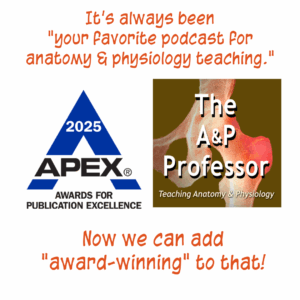
Stay Connected
The easiest way to keep up with new episodes is with the free mobile app:


Or wherever you listen to audio!
Click here to be notified by email when new episodes become available (make sure The A&P Professor option is checked).
Call in
Record your question or share an idea and I may use it in a future podcast!
Toll-free: 1·833·LION·DEN (1·833·546·6336)
Email: podcast@theAPprofessor.org
Share

Kevin's bestselling book!
Available in paperback
Download a digital copy
Please share with your colleagues!
Tools & Resources
TAPP Science & Education Updates (free)
TextExpander (paste snippets)
Krisp Free Noise-Cancelling App
Snagit & Camtasia (media tools)
Rev.com ($10 off transcriptions, captions)
The A&P Professor Logo Items
(Compensation may be received)
